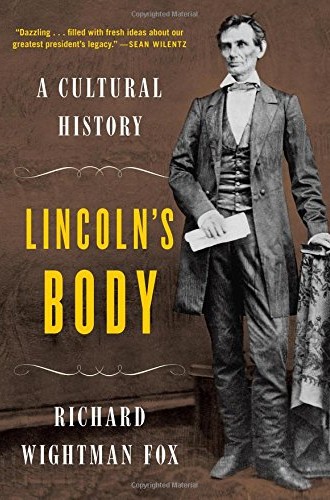Homely Abe
Inside the Petersen House, across from the reconstructed Ford’s Theater in the nation’s capital, stands a 34-foot tower of 6,800 books. Not actual books, but fireproof aluminum in the shape of books. Those 6,800 volumes represent nearly half of those written about the martyred 16th president of the United States. Clearly, there is an insatiable appetite for books about Abraham Lincoln. Such an abundance also means that new Lincoln-themed books must justify their existence. What more is there to learn about this much-studied and much-depicted man?
Today Lincoln is most remembered for his ideals, particularly those expressed in the Gettysburg Address and in his Second Inaugural Address. He symbolizes both union and freedom to millions of people in the United States and beyond. During his lifetime, people not only paid attention to Lincoln’s ideas, they were fascinated with his appearance. That is the starting point for Richard Wightman Fox’s Lincoln’s Body: A Cultural History.
Read our latest issue or browse back issues.
Americans were of many minds about Lincoln’s politics, but they were nearly unanimous in finding his appearance either odd or repulsive. He was often described as “grotesque” because of “his almost alien, otherworldly dimensions: six foot four (eight or nine inches taller than the average man of the day), massive head, narrow shoulders, short trunk, and endless legs.” The best that Lincoln supporter Walt Whitman could manage was to say that his face was “so awful ugly it becomes beautiful.” Lincoln’s detractors were merciless in mocking his looks, so Lincoln gamely joined in the fun. “In my poor, lean, lank face,” he joked, “nobody has ever seen that any cabbages were sprouting out.”
Fox rightly suggests that Lincoln’s body particularly mattered to people because prior to the Civil War, Lincoln—“the rail-splitter”—mixed with them in a way no national politician would normally hazard. It pained Lincoln to sneak into Washington for his inauguration in order to avoid a credible threat of assassination. Despite ongoing threats, Lincoln often flew the coop. He would ride unescorted to his Soldier’s Home cottage, and he walked to the theater without his guards. During the war he walked through fields of carnage after battles ended. Only days before his assassination, he walked through conquered Richmond, greeting freed slaves and Union troops.
Thus, after John Wilkes Booth murdered Lincoln, the public retained a claim on his body. Everyone from Mary Todd Lincoln to government clerks sought relics, such as his hair or blood-stained pieces of his clothing. Americans instantly understood him as another Christ (ironic because Lincoln preferred the Old Testament and did not believe in Jesus’ divinity) or another Moses. Millions of Americans wanted to see their fallen leader, and the embalmers promised that Lincoln would not decay for months. They were wrong. Journalists traced the dissolution of Lincoln’s body with macabre interest as his funeral train wound its way to Illinois. When Lincoln’s corpse reached Springfield, 75,000 mourners saw his dark and withered flesh. Over the next 20 years, Lincoln’s coffin was opened on several occasions. There was even one attempted body snatching, in 1876.
Even before Lincoln’s body was interred, Americans were contesting the meaning of his life and death. While most northerners—Republicans and Democrats alike—mourned Lincoln, Radical Republicans had been wary of his professions of conciliation toward the South and believed that God had taken Lincoln at such a time so others could more thoroughly reconstruct the region. Many white southerners quickly bought into this line of thinking, maintaining—probably incorrectly—that if Lincoln had lived he would have spared them horrors such as black suffrage.
Fox also traces Lincoln’s contested identity in the 150 years since his death, returning to narratives already well told by historians such as David Blight. Although African Americans continued to celebrate Lincoln as an emancipator, by the end of the 19th century white northerners overwhelmingly privileged Lincoln’s role as the savior of the Union. “Southerners know,” Chief Justice William Howard Taft stated at the 1922 dedication of the Lincoln Memorial, “that the greatest misfortune in all the trials of that section was the death of Lincoln.” Only a small segregated section of seating was reserved for African Americans at the dedication.
From 1922 forward, the memorial ensured that Lincoln’s body itself would remain a potent symbol. When Howard University invited the renowned contralto Marian Anderson to perform in Washington in the spring of 1939, its officials could not book an appropriate venue that would permit a black artist to perform. Secretary of the Interior Harold Ickes persuaded President Franklin Roosevelt to make the Lincoln Memorial available for her performance, so a crowd of 75,000 black and white persons heard Anderson sing with the statue of Lincoln behind her. Martin Luther King Jr. delivered an address in Lincoln’s shadow for the first time in 1957. When he spoke there again six years later, many Americans now understood him as the second emancipator.
Fox observes that by the time of King’s 1963 “I Have a Dream” speech, the Lincoln cult was flagging. Indeed, when Barack Obama walked up the steps of the Lincoln Memorial the day before his inauguration, some African-American critics sharply criticized Lincoln’s shortcomings as a symbol for racial equality. Throughout his political career, Lincoln was against slavery, but that did not make him a supporter of social equality. Indeed, as late as 1862 Lincoln encouraged free African Americans to emigrate to Central America to dig coal. Although such criticisms are needed correctives to more hallowed views of Lincoln, they ignore the evolution in Lincoln’s thought toward the end of the war.
Meanwhile, Disneyland’s out-of-date Great Moments with Mr. Lincoln no longer draws crowds. However, American fascination with Lincoln continues, revived during the Civil War sesquicentennial and especially by Steven Spielberg’s 2012 film Lincoln.
Sometimes in the book Fox fails to sustain his focus on Lincoln’s physical presence. After all, Lincoln’s body would mean little to Americans were it not for his accomplishments and ideas. Still, Fox’s thoughtful interweaving of how black and white, northern and southern Americans commemorated, contested, and reshaped Lincoln’s legacy reminds us of both the potential and the perils of public memory.






